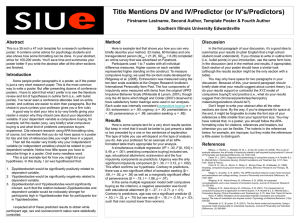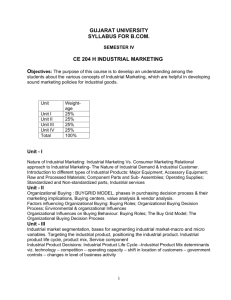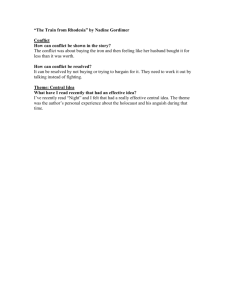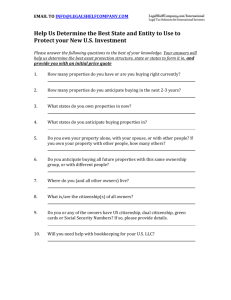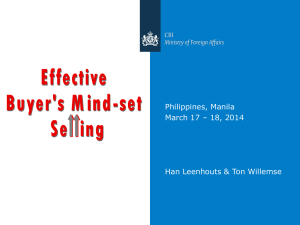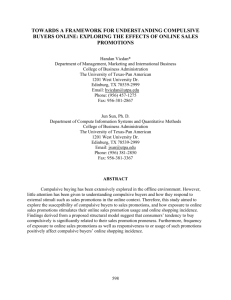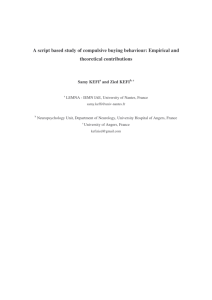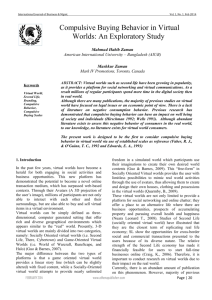Compulsive Buying Scales
advertisement
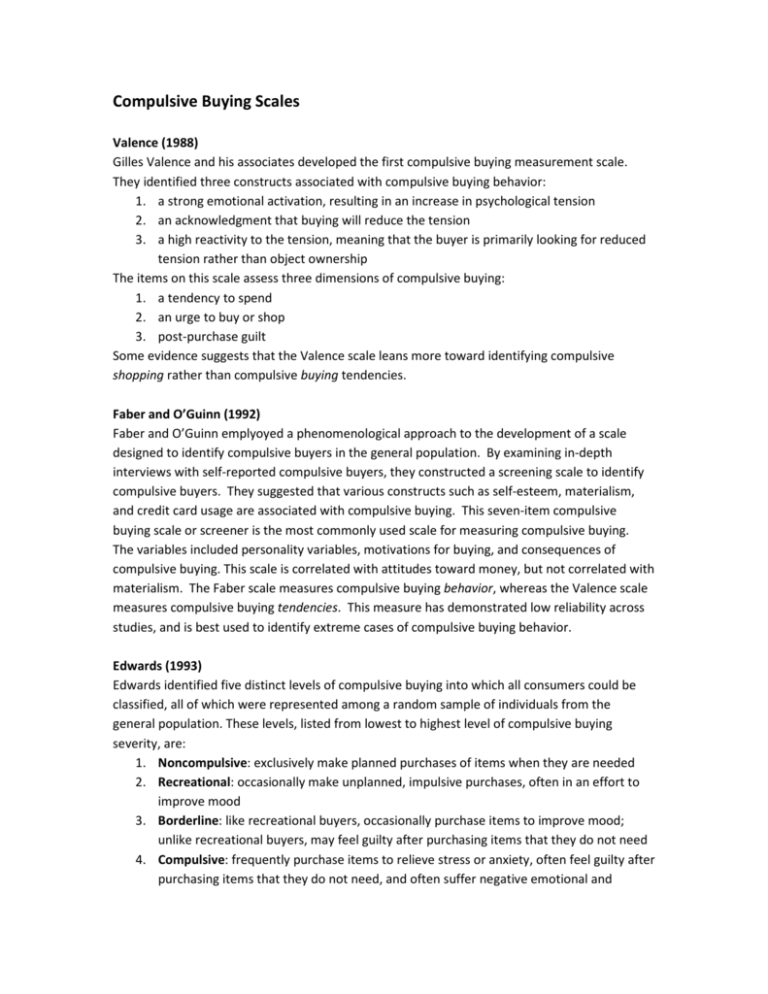
Compulsive Buying Scales Valence (1988) Gilles Valence and his associates developed the first compulsive buying measurement scale. They identified three constructs associated with compulsive buying behavior: 1. a strong emotional activation, resulting in an increase in psychological tension 2. an acknowledgment that buying will reduce the tension 3. a high reactivity to the tension, meaning that the buyer is primarily looking for reduced tension rather than object ownership The items on this scale assess three dimensions of compulsive buying: 1. a tendency to spend 2. an urge to buy or shop 3. post-purchase guilt Some evidence suggests that the Valence scale leans more toward identifying compulsive shopping rather than compulsive buying tendencies. Faber and O’Guinn (1992) Faber and O’Guinn emplyoyed a phenomenological approach to the development of a scale designed to identify compulsive buyers in the general population. By examining in-depth interviews with self-reported compulsive buyers, they constructed a screening scale to identify compulsive buyers. They suggested that various constructs such as self-esteem, materialism, and credit card usage are associated with compulsive buying. This seven-item compulsive buying scale or screener is the most commonly used scale for measuring compulsive buying. The variables included personality variables, motivations for buying, and consequences of compulsive buying. This scale is correlated with attitudes toward money, but not correlated with materialism. The Faber scale measures compulsive buying behavior, whereas the Valence scale measures compulsive buying tendencies. This measure has demonstrated low reliability across studies, and is best used to identify extreme cases of compulsive buying behavior. Edwards (1993) Edwards identified five distinct levels of compulsive buying into which all consumers could be classified, all of which were represented among a random sample of individuals from the general population. These levels, listed from lowest to highest level of compulsive buying severity, are: 1. Noncompulsive: exclusively make planned purchases of items when they are needed 2. Recreational: occasionally make unplanned, impulsive purchases, often in an effort to improve mood 3. Borderline: like recreational buyers, occasionally purchase items to improve mood; unlike recreational buyers, may feel guilty after purchasing items that they do not need 4. Compulsive: frequently purchase items to relieve stress or anxiety, often feel guilty after purchasing items that they do not need, and often suffer negative emotional and economic consequences as a result of their purchasing behavior 5. Addicted: experience a continuous, powerful urge to purchase items that is so strong that they often neglect other obligations and postpone or cancel other activities to act on this urge Richmond (2008) This newest assessment tool developed by Ridgway for measuring compulsive buying behavior differs from its predecessors in a variety of ways. For one thing, it sees compulsive buying as partly obsessive-compulsive--an anxiety disorder--and partly an impulse-control disorder. (Most previous researchers have considered compulsive buying to be solely an impulse-control disorder and, as a result, have omitted items relating to the compulsive nature of the problem.) In addition, previous scales almost always included financial and debt issues; but we now know there are compulsive buyers without financial problems, although if they keep on spending, they may well have some in the future. Finally, this scale specifically addresses buying rather than shopping--one can, after all, shop compulsively without ever buying. As opposed to the Faber scale, Ridgway’s scale focuses more on actual characteristics of compulsive buying instead of its consequences. Yale-Brown Obssessive Compulsive Scale – Shopping Version (1996) Monahan and colleagues modified the Yale-Brown Obsessive-Compulsive Scale (1989) to create the YBOCS-Shopping Version (YBOCS-SV) to assess cognitions and behaviors associated with compulsive buying. Like its sister instrument, the YBOCS-SV consists of 10 items, five of which rate preoccupations, and five which rate behaviors. For assessing both preoccupations and behaviors, subjects are asked about time involved, interference due to the preoccupations or behaviors, distress associated with shopping, the resistance to the thoughts or behavior, and degree of control over the symptoms. Items are rated from 0 (none) to 4 (extreme), and scores can range from 0 to 40. In the sample described by Monahan et al. (1996), the mean YBOCS-SV score for untreated compulsive shoppers was 21 (range 18-25), and 4 (range 1-7) for normal shoppers. EXISTING SCALES MEASURING COMPULSIVE BUYING Developers/Date Valence, d’Astous and Fortier/1988 Scale Name Compulsive Buying Measurement Scale Scale Characteristics 13 items; α between .78-.92; compulsive group scored significantly higher than normal group; acceptable fit measures of GFI = .92, AGFI = .87, RMSQR = .06 Faber and O’Guinn/1992 Compulsive Buying Scale Edwards/1993 Compulsive Buying Scale (not the same scale as the one named above) Monahan, Black and Gabel/1995 Modified the existing Yale-Brown ObsessiveCompulsive Scale— Shopping Version (Goldman et al. 1989a and b) 7 items; able to correctly classify 88% of compulsives and non-compulsives based on scale score; selfidentified compulsives score much lower (meaning more compulsive) than do control samples; acceptable fit measures in confirmatory of GFI = .96, AGFI = .91, RMSQR = .05 (Cole and Sherrell 1995) 13-items; α = .91; 5 factors—tendency to spend; compulsion/drive to spend; feelings about shopping and spending, dysfunctional spending and postpurchase guilt; GFI=.912, AGFI=.855, RMR=.041 10 items--5 deal with preoccupations and 5 deal with behaviors; purpose is to measure the severity and change in diagnosed compulsive buyers Limitations Some low reliability scores; authors found 1 and 4 factors, Cole and Sherrell (1995) found 3 factors with low α = .69, .81 and .61, respectively; factor loadings in confirmatory low (.22, .55 and .39) 6 of 12 items deal with shopping, not buying Very little traditional reliability/validity testing; Cole and Sherrell (1995) found 1 factor and α = .76; in same study, average variance extracted was low (.33); factors loadings for 4 of 7 items were low (.44, .50, .37 and .56); three items refer to shopping rather than buying and three items deal with outcomes of compulsive buying. In confirmatory factor analysis, 4 of 5 factors have only 2 items; three factors seem very similar—tendency to spend, compulsion to spend and dysfunctional spending; very little reliability/validity information available Interview format; used during clinical drug trials to measure “thoughts about shopping” not buying.; low α = .65 and .70; low testretest reliability was .59; very small sample (10).

